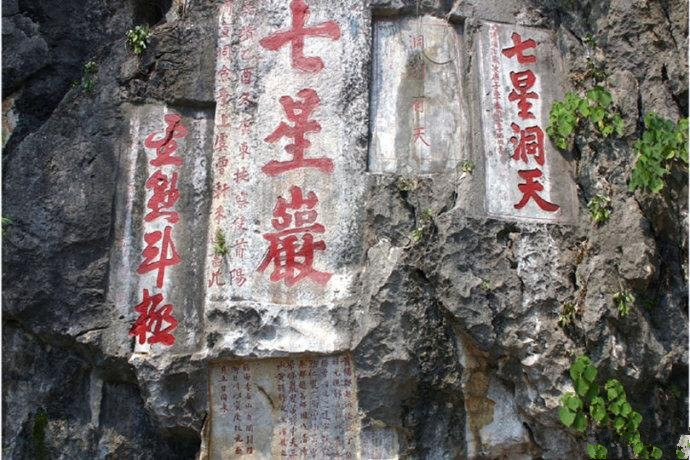Cliff Inscriptions of Zanziyan in Luquan County, Kunming
Introduction to Zanziyan Cliff Inscriptions
The Zanziyan Cliff Inscriptions (錾字岩摩崖石刻) are located on the west bank of the Zhangjiu River, north of Faming Village in Pingshan Town, Luquan County, Kunming. They consist of two Han Chinese inscriptions and one Yi script inscription. The two Han inscriptions, “Record of the Feng Family’s Hereditary Title of Governor” (武定军民府土官知府凤世袭脚色记) and “Genealogy of the Feng Family” (凤公世系), are noted for their accuracy and detail, providing more comprehensive information on several topics than historical texts like the “Ming History” (《明史土司传》), “Records of Local Officials” (《土官底薄》), “Yunnan Gazetteer” (《云南通志》), and various local histories of Wuding and Luquan. The Yi inscription, measuring 2 meters in width and 82 centimeters in height, contains 33 lines of text totaling 563 characters, framed with a double line of sunflower leaves. It primarily documents the lineage of the Luo Wu (罗婺部) chiefs over 350 years.
These inscriptions are among the key protected cultural relics in Yunnan, showcasing the best-preserved examples of Yi and Han inscriptions. They serve as invaluable resources for studying the local history of Luquan during the Song, Yuan, and Ming dynasties, as well as for understanding the development of the Yi people’s history, language, art, and culture.
Historical Significance of the Inscriptions
Dating back over 400 years, the Yi script inscriptions at Zanziyan are among the most intact examples of Yi stone inscriptions today. They were left by the Feng family, local chieftains during the Song dynasty, who claimed to lead the Luo Wu tribe, known as “the dominant of the thirty-seven tribes.” This stone inscription provides important historical data for researching the political, economic, military, cultural, and religious aspects of ancient Yi society. According to the inscriptions, ancestor worship is a major ritual among the Yi people.
The “Genealogy of the Feng Family”
The “Genealogy of the Feng Family” (《凤公世系》) was inscribed by Xu Jin, the governor of Luquan, in the twelfth year of the Jiajing era of the Ming dynasty (1533 AD). It provides a thorough account, beginning from the reign of Emperor Xiaozong during the Chunxi era (1163–1189 AD) when the Heiquan clan conquered the Dali Kingdom’s King Duan Zhixing. The document continues through fourteen generations to the Jiajing period, detailing the political actions of the Feng family. The content reflects a quarter of the Song and Yuan dynasties’ political history and three-quarters of the Ming dynasty, particularly highlighting significant political events.
The inscription titled “Record of the Feng Family’s Hereditary Title of Governor” details the lineage of Feng Ying’s great-grandmother, Shang Sheng, who, along with her clan, pledged allegiance to the Ming dynasty. It chronicles over 130 years of family governance, royal tributes, and Feng Ying’s key political and military activities, providing vivid descriptions of events closely associated with Feng Ying’s life.
Yi Script Inscriptions at Zanziyan
The two Han inscriptions document credible historical facts, often with greater detail than texts like “Ming History” and various local histories, making them of high historical value.
The ancient Yi inscription (Feng Family Stele), also known as the “Stele of the Flourishing Luo Wu Era” (《罗婺盛世贤代碑》), is quite lengthy and is mentioned in the twelfth volume of the Luquan County Gazetteer. It states: “One inscription is in Cuàn script, untranslatable, suspected to be a translation of the Han script.” Legend has it that the Zanziyan stele contains hidden treasures left by the Feng chieftains. Those who understand the inscription are believed to be able to obtain vast amounts of gold and silver.
A local folktale recounts that during a hot summer, two traveling merchants, weary and thirsty, came upon a small temple at Zanziyan. One fell asleep and dreamt of an old woman who said, “To the right under the eaves, there’s a vat of silver you may take.” While his companion slept, he secretly dug up the silver. When the other woke and saw the fresh hole, he feigned sleep and heard a yellow oriole singing, “Seek silver, ask old Li across the way…” Delighted, he jumped up, found a silver vat beneath a plum tree, and word spread rapidly, bringing many to study the Yi inscriptions for hidden secrets.
Research and Analysis of the Inscriptions
After extensive research by Yi scholars, the mystery of the inscriptions was unraveled. The Yi inscriptions date back to the twelfth year of the Jiajing era (1533 AD) and were inscribed by ancestors Feng Awei and Feng Lai. The cliff measures 2 meters wide and 0.82 meters high, containing 124 phrases and 578 characters, bordered with a double line of sunflower leaves. The primary content chronicles the lineage of the Luo Wu tribe’s chief leaders over 350 years.
The inscriptions document the achievements of the Feng family, their military strength, and their responses to imperial commands, as well as their ancestor worship ceremonies. Notably, the records indicate that after each successful military campaign, a grand ancestral ceremony was held, a common trait among the four major ceremonies recorded.
Conclusion on Yi Ancestral Worship
The essence of Yi ancestral worship, referred to in their language as “Naime,” emphasizes gratitude to ancestors for their protection, recounting genealogy, and guiding the spirits home. During these ceremonies, all members of the same clan, regardless of status, have both the obligation and right to participate, generally occurring every thirteen years on auspicious days. In primitive religious beliefs, the soul’s immortality was paramount, leading to the concept of ancestor worship.
The Zanziyan Yi inscriptions reflect the Yi people’s belief that ancestral spirits protect their descendants, significantly linking warfare successes to ancestral blessings. Thus, Feng family ceremonies were expressions of gratitude and recognition of ancestral contributions to family prosperity. This broader understanding of Yi ancestral worship provides insights into their religious, cultural, and historical contexts, serving as a vital aspect of studying Yi society.
Location:
https://tieba.baidu.com/p/4355757908?red_tag=3206270065















